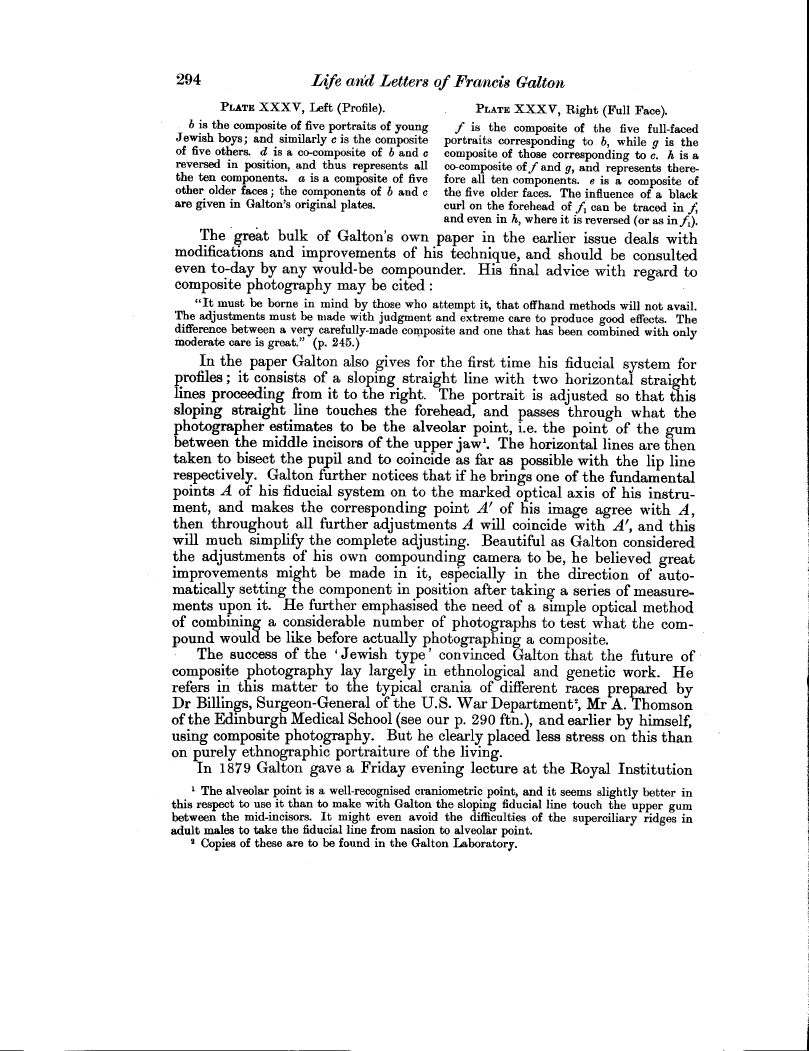294 Life and Letters of Francis Galton
PLATE XXXV, Left (Profile). PLATE XXXV, Right (Full Face).
b is the composite of five portraits of young f is the composite of the five full-faced Jewish boys; and similarly c is the composite portraits corresponding to b, while g is the of five others. d is a co-composite of b and c composite of those corresponding to c. h is a reversed in position, and thus represents all co-composite off and g, and represents therethe ten components. a is a composite of five fore all ten components. e is a composite of other older faces ; the components of b and c the five older faces. The influence of a black
are given in Galton's original plates. curl on the forehead of f, can be traced in f,
and even in h, where it is reversed (or as in f,).
The great bulk of Galton's own paper in the earlier issue deals with modifications and improvements of his technique, and should be consulted even to-day by any would-be compounder. His final advice with regard to composite photography may be cited
"It must be borne in mind by those who attempt it, that offhand methods will not avail. The adjustments must be made with judgment and extreme care to produce good effects. The difference between a very carefully-made composite and one that has been combined with only
moderate care is great." (p. 245.)
In the paper Galton also gives for the first time his fiducial system for profiles ; it consists of a sloping straight line with two horizontal straight lines proceeding from it to the right. The portrait is adjusted so that this sloping straight line touches the forehead, and passes through what the photographer estimates to be the alveolar point, i.e. the point of the gum between the middle incisors of the upper jaw'. The horizontal lines are then taken to bisect the pupil and to coincide as far as possible with the lip line respectively. Galton further notices that if he brings one of the fundamental points A of his fiducial system on to the marked optical axis of his instrument, and makes the corresponding point A' of his image agree with A, then throughout all further adjustments A will coincide with A', and this will much simplify the complete adjusting. Beautiful as Galton considered the adjustments of his own compounding camera to be, he believed great improvements might be made in it, especially in the direction of automatically setting the component in position after taking a series of measurements upon it. He further emphasised the need of a simple optical method of combining a considerable number of photographs to test what the compound would be like before actually photographing a composite.
The success of the `Jewish type' convinced Galton that the future of composite photography lay largely in ethnological and genetic work. He refers in this matter to the typical crania of different races prepared by Dr Billings, Surgeon-General of the U.S. War Department', Mr A. Thomson of the Edinburgh Medical School (see our p. 290 ftn.), and earlier by himself, using composite photography. But he clearly placed less stress on this than on purely ethnographic portraiture of the living.
In 1879 Galton gave a Friday evening lecture at the Royal Institution
i The alveolar point is a well-recognised craniometric point, and it seems slightly better in this respect to use it than to make with Galton the sloping fiducial line touch the upper gum between the mid-incisors. It might even avoid the difficulties of the superciliary ridges in
adult males to take the fiducial line from nasion to alveolar point.
2 Copies of these are to be found in the Galton Laboratory.

